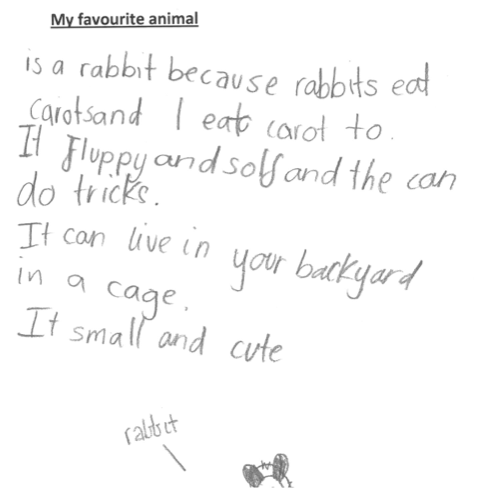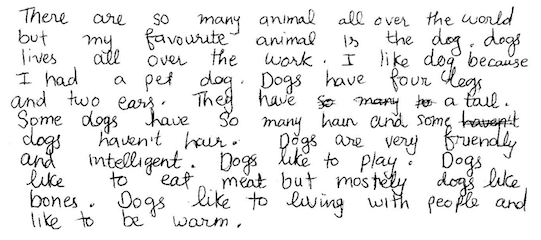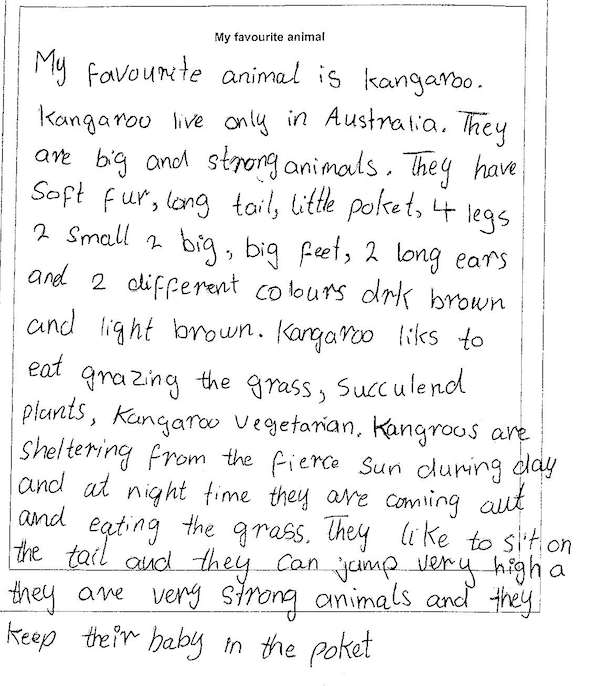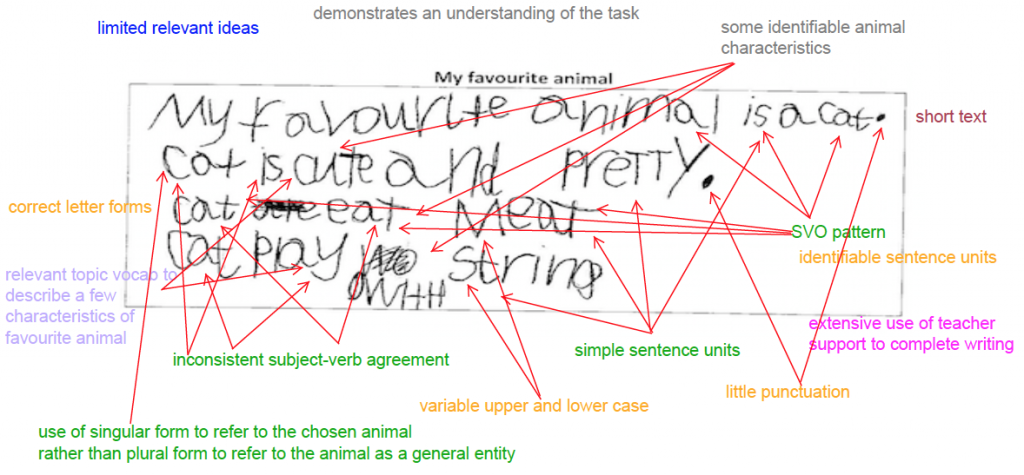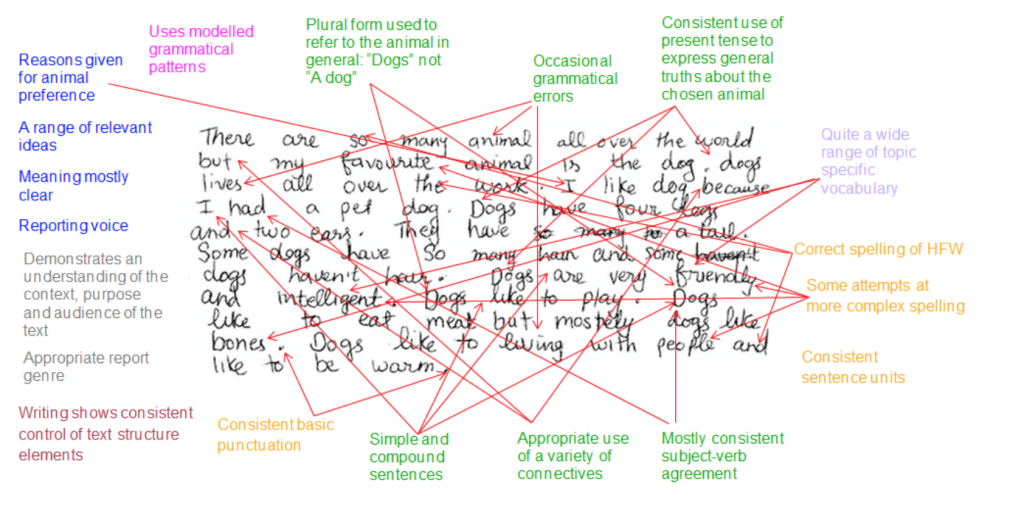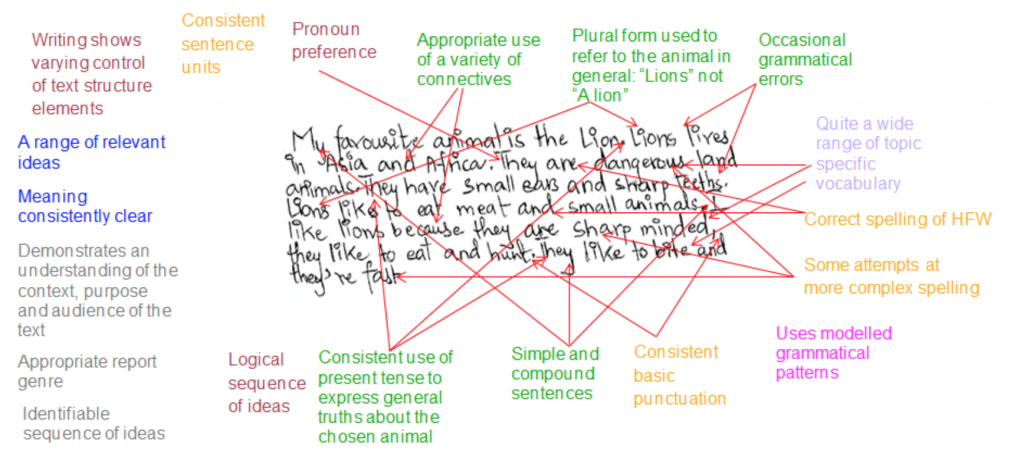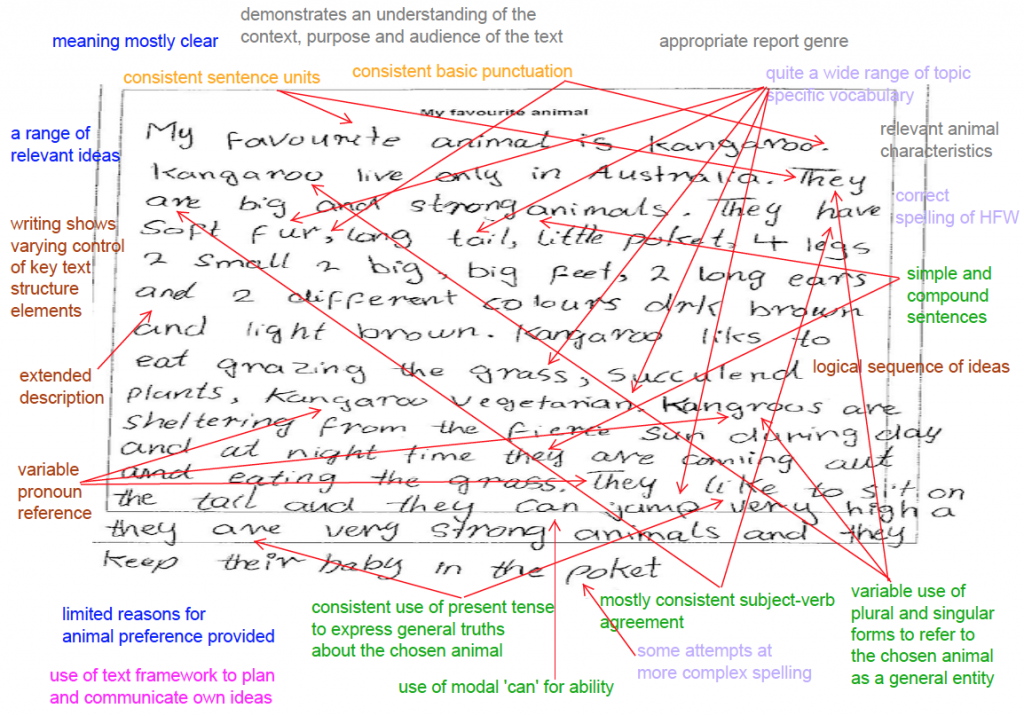2. My favourite animal
Please click on the toggles below to navigate through information on this assessment task and reveal the links for downloading task materials.
Task details |
|
| Name of writing assessment task | My favourite animal |
| EAL curriculum level range | A2, B1, B2, C1, C2 |
| Text orientation | Informative |
| Task type | Extended response |
Task specification |
|
| Purpose | To assess students' ability to construct simple factually informative texts to describe the physical appearance of their favourite animal, identify the country/countries where their animal can be found, what their animal eats, drinks and their typical activities. Students should also explain why this particular animal is their favourite. |
| Description | Students individually complete a factual description of their favourite animal, based on the modelled sentence starters (See 'Sample text and questions' below in 'Task implementation'). Students illustrate and label their favourite animal. |
| Assumed knowledge and description |
|
Learning/teaching context |
|
| Language centre/mainstream class | EAL support |
| Subject/key curriculum objectives, outcomes | Science |
| Topic/teaching unit | Unit of work around pets, zoo or farm animals |
| Assessment conditions |
|
| Notes |
|
Task implementation |
|
| STAGE | ACTION STEPS |
| Pre-assessment activity |
CATS My favourite animal is the cat. Cats live in Australia and all over the world. They are small animals. They have soft fur, and can be many different colours. Cats like to eat meat and fish, and they catch mice and birds. Some cats drink milk. Cats sleep a lot and they like to be warm. Cats like living with people. Many people like cats because they are friendly, they purr and they like to play.
|
| Assessment activity |
|
| Post-assessment activity |
|
Click here for the unannotated assessment criteria:
- TEAL Writing Task 2 -unmarked criteria sheet [PDF]
- TEAL Writing Task 2- unmarked criteria sheet [Word]
An explanation of the purpose, nature and use of criteria sheets is available at 4. Using the assessment criteria.
Annotations, commentaries and feedback for Task 2: My favourite animal
Purpose and value of task
This task assesses students’ abilities to write a report about a favourite animal. ‘Animals’ are a familiar topic generally of interest to students, and students often have knowledge about animal habits and attributes in their first language. Once students begin to learn vocabulary sets about body parts, size, foods, colours and so on, they can start to write simple modelled reports about animals. The topic allows them to report what they already know, but also to do some simple research around their chosen animal.
Contextual information
The students in the samples had all had all used the sample frameworks provided to organise information about their animal, and had taken part in modelled text construction with the teacher.
Commentary
This sample shows an understanding of the task and an intention to inform the reader about some of the characteristics of a favourite animal: what it looks like – ‘cute and pretty’, what it eats – ‘meat’, and what it does – ‘plays with string’. There is some control of the text structure with an appropriate initial sentence to introduce the selected animal to the reader. The meaning of the text itself is clear although the range of ideas is limited and the text is very short.
The text shows that the student can express simple ideas but may need to be introduced to more topic vocabulary to add details and elaborate on them. The spelling of high frequency words is accurate with the support of the teacher and environmental print.
The simple present is used throughout the text to refer to general truths about the animal’s appearance and habits
The student is able to form most letters correctly. The inconsistent use of upper and lower case letters shows that this student is just beginning to develop an understanding of their use. Little punctuation is used, but the student has included full stops correctly in two instances which suggests beginning awareness of basic punctuation and how to use it.
The student has made extensive use of teacher support and environmental print to accomplish the task and has written about the same animal as the model provided.
The marked criteria sheet shows that the student meets most criteria at level 1 of performance.
The student’s language use in this task is consistent with the descriptions of students at Level B1, Victorian Curriculum F-10 EAL.
TEAL Writing Task 2 – criteria sheet – Sample 1
Using this assessment for further learning
(Select the points you think are currently of most importance to the student.)
- This student has written about a favourite animal using some relevant ideas to describe what it looks like, what it eats and does. The student would benefit from vocabulary extension activities so that more details can be added. For example, during a teacher-student conference, the student can be shown pictures of cats and, in relation to ‘Physical appearance’, asked questions to elicit more nouns: fur, tail, paws, claws etc., and adjectives to describe these features to extend the description of a cat’s physical appearance. If the student does not yet know these quite specific vocabulary items, they can be added to the student's personal dictionaries. The teacher could do something similar with ‘What cats do’. The teacher or the student could build up simple charts like the ones below:
Physical appearance:
|
Animal |
Verb |
Adjective |
Noun |
| Cats | have |
soft black white orange grey soft, black, white orange or grey |
fur |
| They | have |
long wavy long, wavy |
tails |
| They | have |
long sharp long, sharp |
claws teeth |
What cats do:
| Cats | play | with string |
| They | purr | |
| They | hunt | mice |
| They | sleep | |
| They | like |
warm places soft beds |
- The student has written about a particular ‘cat’ rather than ‘cats’ in general so clarify this idea with the student so that she refers to ‘cats’ rather than ‘cat’ in the text.
Cats are cute They eat meat They play with string
- Give the student time and support to write and illustrate another draft, using the charts you have built up together. Add the product to the student’s portfolio.
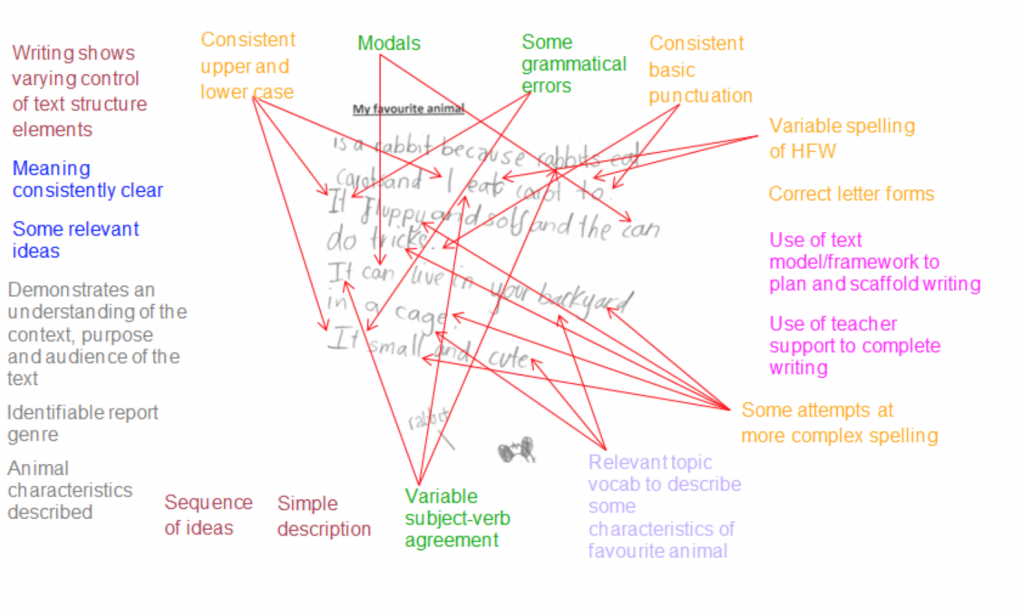
Commentary
This sample shows that the writer can communicate meanings clearly throughout a text and demonstrates that the writer has an understanding of the context, purpose and audience of the text. There is an identifiable report genre and some relevant animal characteristics have been described. The text is short but shows some control of key text structure elements. The sample includes simple descriptions of the animal, the food it eats and typical behaviour. The ideas are logically sequenced. The writer shows some ability to use the present tense to refer to general truths about the chosen animal as in the opening sentence: ‘My favourite animal is a rabbit …’, but tends to omit the verb form in other parts of the text, as in: ‘It fluppy (fluffy)’ and ‘It small and cute’. The student begins by using the plural form ‘rabbits’ to make a general reference to the species which would be appropriate for this text, but then continues to use the singular pronoun ‘it’ to refer to a specific entity rather than the species in general. The writer has successfully used the modal ‘can’ to refer to ability as in: ‘… can do tricks’, and ‘It can live in …’, but as mentioned above there is variable subject verb agreement because the verb has been omitted, as in ‘It fluppy (fluffy)’ and ‘It small and cute’.
The writer has chosen some relevant topic vocabulary such as: carots (carrots), cage, small, backyard, fluppy (fluffy) cute, and solf (soft). The spelling of high frequency words is variable. Letters are formed correctly and upper and lower case letters are used appropriately. Full stops are used consistently to mark sentence units.
The writer made use of the text framework and teacher support to scaffold the writing.
The marked criteria sheet shows that the student meets some criteria at level 2 of performance and some at level 3.
The student’s language use in this task is consistent with the descriptions of students at Level B2, Victorian Curriculum F-10 EAL.
TEAL Writing Task 2 – criteria sheet – Sample 2
Using this assessment for further learning
(Select the points you think are currently of most importance to the student.)
- This student has written a short text including some relevant ideas to describe the main characteristics of a favourite animal. During the teacher-student conference the teacher could see if the student can work out how to spell some of the key words to describe rabbits, by sounding out the letters for ‘fluffy’ and ‘soft’. Show the student the written form of ‘carrot’ to see if he or she can self-correct. Encourage the student to copy these words again.
- The student begins by using the plural form to refer to ‘rabbits’ in general which is appropriate for this text, but then uses the singular pronoun ‘it’ to refer to a specific entity. Clarify with the student the use of 'it' and 'they', emphasising that 'they' refers to ‘rabbits’ in general. At the same time elicit the verb form that should appear in the middle column below to see if the student can self-correct the omission of the verb form in some of the sentence units.
- It might be worth extending the student’s vocabulary a little and introduce the word ‘a hutch’ to refer to the special cage pet rabbits live in.
| Rabbits | eat | carrots |
| Rabbits (They) | are | fluffy and soft |
| They | are | small and cute |
| They | can do | tricks |
| They | can live | in your backyard |
- Give the student time and support to write and illustrate another draft, using the spellings of words and the chart you have built up together. Add the final product to the student’s portfolio.
Commentary
This sample shows an understanding of the task and an intention to inform the reader about many of the characteristics of a favourite animal. The writer has adopted an appropriate report genre. There is consistent control of the required text structure. The text begins with a clear introduction and goes on to include a logical sequence of ideas moving from where the animal can be found, its physical appearance, what it eats and typical behaviour. The reasons for choosing the dog as a favourite animal are made clear, although the text could be improved by putting this element either closer to the beginning or as the concluding statement.
The text shows that the student can express a range of ideas on the topic and can include some extended description.
The simple present is used throughout the text to refer to general truths about the dog’s habitat, appearance and behaviour. The writer uses plural forms to refer to dogs in general which is appropriate for this text. The ‘article + noun pattern’ is used to refer generally to the species as in ‘…my favourite animal is the dog’. Subject verb agreement is generally consistent although there is an error with this as in ‘dogs lives…’ . The writer uses both simple (1) and compound sentences (2): 1. ‘Dogs lives all over the work (world) 2. ‘There are so many animal(s) all over the world but my favourite animal is the dog’. He uses a variety of connectives appropriately. There are some grammatical errors showing that the writer is struggling with expressing uncountable forms and negation as in: Dogs have so many (much) hair’ and ‘some dogs haven’t hair’ (don’t have). There are some other issues which are not consistent throughout, for example, the overuse of ‘dogs’ rather than ‘they’. Generally the writer uses correct plural forms but in the opening sentence writes ‘There are so many animal (animals)…’ Generally the writer has used the infinitive form after ‘like to’ with one inconsistency, ‘Dogs like to living…’.
The student has used a range of vocabulary to write about a favourite animal, though the use of the word ‘fur’ rather than ‘hair’ would have been more appropriate in this text. He has spelled most items correctly, including the more complex word ‘intelligent’. There is evidence of consistent use of sentence units and consistent basic punctuation. There is some inconsistency with capitalisation.
The student has made use of modelled grammatical patterns.
The marked criteria sheet shows that the student meets most criteria at level 3 of performance.
The student’s language use in this task is consistent with the descriptions of students at Level B2, Victorian Curriculum F-10 EAL.
TEAL Writing Task 2 – criteria sheet – Sample 3
The student’s language use in this task is consistent with the descriptions of students at Level B2, Victorian Curriculum F-10 EAL.
Using this assessment for further learning
(Select the points you think are currently of most importance to the student.)
- This student has written confidently about a favourite animal, using a range of relevant ideas to describe what it looks like, what it eats and does. Encourage the student to extend ideas and write a little more about each element. During a teacher student conference ask the students questions such as:
- Why do we have dogs all over the world?
- Do we like living with dogs? Why? Elicit ideas such as ‘man’s best friend’, ‘domesticated' as opposed to 'wild’ etc, working dogs and dogs kept aw pets.
Show pictures of different dogs and elicit other ways to describe them:
- big, small, to have a smooth coat, to have lots of fur or to have so much fur, to be furry, many colours, black, white, brown or a combination etc.
Elicit other things dogs are well known for as well as being friendly and intelligent:
- helpful – guide dogs – dogs can make us feel better – some dogs visit hospitals, hunting dogs etc. just to extend his ideas.
Help the student to make notes or provide notes for him as they are raised during the discussion.
- Encourage the student to use pronouns more often rather than repeating the word ‘dogs’. Ask what word he could be used instead of ‘dogs’. 'They’ is used in the text so ask the student to identify where this word could be used again.
- See if the student can self-correct the singular form of ‘animal’ in the opening sentence.
- Help the student to differentiate between the use of ‘many’ and ‘much’ when used with the pattern ‘so + much/many’
-
Many or much? Countable Uncountable I have so _________________ friends I have so_________________ hair I have so _________________ homework I have so _________________ pens I have so _________________ rice on my plate
See if the student can work out how to improve the example of negation in writing: some dogs haven’t hair (fur). Show him the statement, and elicit the yes/no question form and the yes/no response as illustrated below and see if he or she can work out the negative form. Then see if the student can transfer this to the text.
- Statement: All dogs have fur
- Question: Do all dogs have fur?
- Answer Yes they do / No they don’t
- Negative: Some dogs don’t have fur
- Point out how well the student has spelt most vocabulary in the text, even quite difficult words such as ‘friendly’ and ‘intelligent’. See if he/or she can identify the correct spelling of ‘mostly’.
- Give the student time and support to write and illustrate another draft. Add the final product to the student’s portfolio.
Evidence of consistent use of sentence units and consistent basic punctuation and capitalisation.
The student has made use of modelled grammatical patterns.
The marked criteria sheet shows that the student meets most criteria at level 3 of performance.
The student’s language use in this task is consistent with the descriptions of students at Level C2, Victorian Curriculum F-10 EAL.
TEAL Writing Task 2 – criteria sheet – Sample 4.
Using this assessment for further learning (Select the points you think are currently of most importance to the student.)
- This student has written confidently about a favourite animal, using a range of relevant ideas to describe what it looks like, what it eats and does. The student could be encouraged to extend on some ideas and write a little more about each element. During a teacher-student conference, show the student some pictures of lions and ask questions such as:
- Do lions like to live in cold, wet countries or hot, dry countries?
- Do lions live in groups?
- What do we call a group of lions?
- What do we call baby lions?
- What colour are lions?
- What do we call the hair around a lion’s neck?
- Are their paws big or small?
- Are their claws / teeth long and sharp?
- Who hunts for food? The male or the female?
- Who takes care of the cubs? The male or the female?
- Help the student to make notes or provide notes as they are raised during the discussion.
- See if the student can self-correct the subject-verb agreement in the second and fifth sentences.
- Help the student to notice different ways of forming plurals
-
Noun Regular plural Irregular plural Apple Apples Orange Oranges Lion Lions Tooth Teeth Child Children Mouse Mice
- Give the student time and support to write and illustrate another draft. Add the final product to the student’s portfolio.
Commentary
In this sample the student shows an understanding of the task and an intention to inform the reader about many of the characteristics of a favourite animal. An appropriate report genre is used. There is varying control of the required text structure. The text begins with a clear introduction and goes on to include a logical sequence of ideas moving from where the animal can be found, its physical appearance, what it eats and typical behaviour. The reasons for choosing the kangaroo as a favourite animal are however rather implicit. A concluding paragraph which explains explicitly why the kangaroo is the writer’s favourite animal would have strengthened the text.
The text shows that the student can express a range of ideas on the topic and some extended description is included.
The simple present is used throughout the text to refer to general truths about the kangaroo’s habitat, appearance and behaviour. The writer uses both singular and plural forms to refer to the chosen animal. After the initial identification of the kangaroo, subsequent mentions should use the plural form ‘kangaroos’ in order to refer to them as a general rather than a specific entity. Subject verb agreement is generally consistent although there are one or two errors with this as in ‘kangaroo likes …’ and ‘kangaroo live’. The writer uses both simple and compound sentences. The modal ‘can’ for ability is used accurately as in ‘… they can jump very high’. There are some grammatical errors where the writer uses present continuous aspect rather than the simple present which has the effect of making the intended description of general habits seem like temporary events. There are some other mistakes which are not consistent throughout, such as article use as in ‘My favourite animal is kangaroo’, and expression of possessions as in ‘the tail’ and ‘the poket’. However later the student expresses this relationship accurately as in ‘their baby’ .
The student has used a range of vocabulary and has spelt most items correctly, even the more difficult words, with the exception of ‘pocket’ and ‘succulent’. There is evidence of consistent basic punctuation and the consistent use of sentence units.
The student made use of the text framework to communicate, and made independent use of environmental print to accomplish the task.
The marked criteria sheet shows that the student meets most criteria at level 3 of performance.
The student’s language use in this task is consistent with the descriptions of students at Level C2, Victorian Curriculum F-10 EAL.
TEAL Writing Task 2 – criteria sheet – Sample 5
Using this assessment for further learning (Select the points you think are currently of most importance to the student.)
- This student has written about a favourite animal using a range of relevant ideas to describe what it looks like, what it eats and does. The student changes from using the present simple to using the present continuous to describe typical kangaroo behaviour so it would be helpful to clarify the difference in use between present simple and present continuous, where the former is used to talk about general truths, and the latter is used to describe events which are temporary and possibly happening at the moment of speaking. During the teacher-student conference the teacher could show the student some pictures or a short video clip and ask questions such as: What’s the kangaroo doing now? What do kangaroos always do?
-
In the picture or video clip: NOW / talking about a SPECIFIC group of kangaroos (THE kangaroos in the picture) ALWAYS (Yesterday, today, tomorrow, next week) / GENERAL TRUTH The kangaroos are sheltering from the fierce sun Kangaroos shelter from the fierce sun The kangaroos are coming out to eat Kangaroos come out at night to eat
The student has referred to countable entities in the singular form so this issue may need to be clarified:
|
Uncountable |
Countable, plural |
|
|
soft long little |
fur tails pockets (pouches) |
- Show the student where possession has been expressed correctly and then ask the student to self-correct’ ‘the tail’ and ‘the poket’ and ‘their baby’.
- Point out how well the student has spelt most vocabulary in the text, even more difficult words. Help the student to add to this achievement with the words ‘pocket’, but point out that the word ‘pouch’ is used in this context.
- The student has occasionally written about a particular ‘kangaroo’ rather than ‘kangaroos’ in general so clarify the idea ‘kangaroos’ refers to the animal in general.
-
Kangaroos live only in Australia Kangaroos like to eat grass
- Give the student time and support to write and illustrate another draft, using the charts you have built up together. Add the final product to the student’s portfolio.

